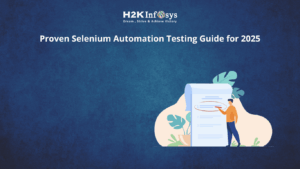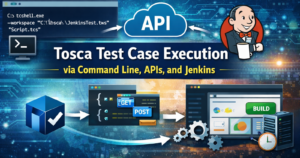Framework is mixture that constitutes of protocols, rules, standards and also guidelines which is incorporated as a whole to leverage the benefits of scaffolding provided by the framework.
The Test automation framework provides an execution environment for the test automation test scripts. It will be more as the system is created to automate our tests.
We can say that a framework will be a constructive blend of many guidelines, coding standards, concepts, processes, practices, modularity, and test data injections to pillar automation testing. By understanding these components and how they work together, professionals can greatly benefit from Selenium testing course, which provide in-depth knowledge and practical experience to effectively implement such solutions.
The selenium framework package of automation testing tools is based on the javascript framework. It executes tests as directly on the required browser, drive interactions on the required page and also return them without any manual input.
Why Selenium automation framework is so popular?
Selenium framework is installed in 41 thousand companies all over the world as it is the highest market share for software testing tools all over.
Mainly the computer software and IT services companies, Selenium has not just restricted itself to them and serves as industries like staffing and recruiting, healthcare and financial services.
Selenium test scripts are coded in java, C#, Python, PHP, Ruby and .Net that has large number of testers to easily use it. It can be carried out many Windows, MacOS and Linux by using any browsers of Mozilla firefox, internet explorer.
Advantages of test automation framework:
- It has reusability of code
- It has maximum coverage
- Recovery scenario
- Low cost maintenance
- Minimal manual intervention
- Easy reporting
Types of Automation framework
There are many automation framework. They are:
- Data driven framework
- Keyword driven framework
- Hybrid framework
Data driven framework:
This framework is based on the different data sets which are created into an external file and are imported into testing tool. When the number of data sets will be test framework which uses the input on the higher side it will be very difficult to change these values in the script where we conduct the test. These data sets keeps it separate from the original script that retrieves the required input each time from the data set excel sheet.
Keyword Driven Framework:
The keywords are the basis of the functionality that takes in parameters and throws the relevant output. When the code has to cover a lot of functionality,this needs repetitive content for certain sections.The methods that are performed are written separately from the actual script as keywords.These keywords which can be kept in an external file are called using the code.The keywords will be available in the table which can be modified each of them individually without hampering others.
Hybrid framework
The hybrid framework is a integration of data-driven and keyword driven frameworks. This framework will use the different keywords and also data sets where the list of inputs and the functions will be stored in separate files. The data-driven framework also uses the same code for different data sets.
When we have to use the Selenium Automation testing Framework?
When we have a large number of data sets which is to be tested for the web application. Then we must opt for data-driven framework which will separate them from the actual script. There are more functionalities which are to be tested for the web application. It is suggested that the team will go for a keyword driven framework where the operations are stored in a separate table in the form of keywords. These keywords are used for specific functional operation.
How to build robust test automation framework for Selenium?
Building a robust test automation setup for Selenium involves several key components and practices. Here’s a step-by-step guide to creating one:
Selecting a Programming Language: Choose a programming language that your team is comfortable with and that is well-supported by Selenium. Popular choices include Java, Python, C#, and JavaScript.
Setting up Dependencies: Use a dependency management tool such as Maven (for Java), npm (for JavaScript), pip (for Python), or NuGet (for C#) to manage dependencies like Selenium WebDriver, testing libraries, and any other required tools.
Selecting a Testing Library: Choose a testing library that integrates well with Selenium and supports features like test organization, assertions, and reporting. Popular options include JUnit and TestNG for Java, pytest for Python, NUnit for C#, and Mocha or Jest for JavaScript.
Implementing Page Object Model (POM): Use the Page Object Model design pattern to create reusable components that represent the pages or sections of your web application. Each page object should encapsulate the elements and actions of the corresponding page.
Handling Test Data: Implement mechanisms to manage test data effectively, including techniques for data-driven testing if applicable. Consider using external data sources like CSV files, Excel sheets, or databases to parameterize your tests.
Implementing Assertions: Use assertion libraries provided by your testing library to validate the expected behavior of your web application. Assertions should cover both positive and negative test scenarios.
Logging and Reporting: Incorporate logging mechanisms to capture relevant information during test execution, such as debug messages, warnings, and errors. Integrate a reporting tool like ExtentReports, Allure, or ReportPortal to generate detailed test reports with execution summaries, screenshots, and failure analysis.
Handling Waits and Synchronization: Implement explicit and implicit waits to handle dynamic elements and asynchronous behavior in your web application. Use WebDriverWait and ExpectedConditions provided by Selenium WebDriver to wait for specific conditions to be met before performing actions.
Parallel Execution: Set up parallel execution to run your tests concurrently across multiple browsers, devices, or environments. Selenium Grid or cloud-based testing services like BrowserStack or Sauce Labs can help achieve parallelism effectively.
Integration with CI/CD Pipelines: Integrate your Selenium automation with Continuous Integration/Continuous Deployment (CI/CD) pipelines to automate test execution on code changes. Use CI tools like Jenkins, Travis CI, or GitLab CI to trigger test runs and generate reports automatically.
Handling Test Environment Configuration: Implement mechanisms to configure test environments dynamically, including URL configurations, browser configurations, and test data setups.
Maintenance and Scalability: Regularly review and refactor your test code to ensure readability, maintainability, and scalability. Follow coding best practices and design principles to keep your setup robust and extensible.
By following these steps and incorporating best practices, you can build a powerful and maintainable test automation framework for Selenium that meets your project’s requirements.
Questions
- What is automation testing? Why is it used with Selenium?
- What are the types of Selenium automation testing?
- What are the key components of Selenium automation?
- How do you choose the right automation testing approach for your project?
- What are the advantages of using Selenium for test automation over other tools?
- Explain the difference between Selenium WebDriver and Selenium IDE.
- How do you integrate Cucumber with Selenium for behavior-driven development (BDD)?
- What are some common challenges faced during Selenium automation testing and how can they be addressed?
- What are Selenium Grid’s features, and when should you use it in testing?
- How do you handle dynamic elements in Selenium automation testing?
Conclusion
Selenium test automation is essential for streamlining and standardizing the testing process in modern software development. It provides a structured approach to designing, executing, and managing test cases, making the testing lifecycle more efficient and less error-prone. By leveraging Selenium’s robust suite of tools, including WebDriver, IDE, and Grid, automation supports cross-browser testing, parallel execution, and seamless integration with continuous integration/continuous deployment (CI/CD) pipelines.
The modular design of Selenium ensures that test scripts are reusable and maintainable, reducing the time and cost associated with manual testing. Moreover, combining Selenium with tools like TestNG, JUnit, or Cucumber facilitates a more comprehensive testing approach, supporting functionality, performance, and behavior-driven testing, which ultimately enhances the overall quality of the application.
In addition to improving efficiency and accuracy, Selenium test automation also enables better collaboration among development, testing, and operations teams. By adopting this approach, teams can focus on addressing complex business requirements while leaving repetitive tasks to automated scripts. The open-source nature of Selenium makes it accessible to organizations of all sizes, providing a cost-effective solution to testing challenges.Whether used in small-scale projects or enterprise-level systems, a well-implemented Selenium strategy promotes scalability, adaptability, and reliability in testing. With the growing importance of delivering flawless user experiences, integrating Selenium test automation into your software development lifecycle is not just an option but a necessity to stay competitive in today’s fast-paced digital world.
Call to action
Are you ready to transform your software testing process and ensure the highest quality for your applications? Start exploring the power of Selenium Test Automation with H2K Infosys today! Whether you’re a beginner seeking to understand the basics or a professional looking to advance your automation skills, mastering Selenium frameworks can be a game-changer for your career and your projects.
With the ability to integrate seamlessly into modern software development workflows, Selenium offers unparalleled flexibility, scalability, and efficiency. Don’t let your testing processes fall behind in today’s competitive tech landscape equip yourself with the knowledge and tools needed to stay ahead.
Take the next step toward revolutionizing your testing strategies by diving deeper into Selenium. Join a comprehensive training program, explore hands-on tutorials, or collaborate with expert mentors to build a robust framework tailored to your project needs. By leveraging Selenium’s versatility, you can reduce testing time, improve accuracy, and deliver exceptional software products that exceed user expectations.The world of Selenium automation is at your fingertips start your journey with H2K Infosys today and unlock new opportunities for professional growth and organizational success. Your path to streamlined, effective, and modern testing begins now!


























